Knotted Muscles in Neck
Introduction
A muscle knot, also known as a trigger point, is a tight region of muscle. It happens when muscles tighten and contract even when they are not moving.
You undoubtedly had a muscle knot if you ever felt a firm, uncomfortable place on your neck or shoulders after sitting at your desk all day. These sensitive areas can cause muscular pain and restrict your range of motion. An estimated 85% of the general population may have a muscle knot at some point in their lives. However, you are not required to tolerate them. Most muscle knots disappear with therapy and good lifestyle changes.
Muscle knots are especially common in your neck. This is because many ordinary activities, like texting or working on a computer, can strain the muscles in your neck. Physical inactivity and mental stress can also cause knots in your neck.
Because muscle knots are sometimes painful, moving your neck may be difficult. Simple self-care methods like stretching and massages, for example, can help provide relief.
What are muscle knots?
A muscle knot is, as the name means, a sensitive, tightened area on your muscle. A muscle knot is a tiny, rigid, and sensitive region within a muscle or set of muscles. It often feels like a lump or nodule and is caused by muscular overuse, stress, or small injury. Knots can appear anywhere on the body, although they are most frequent in the shoulders, neck, and lower back. Muscle knots, while frequently painful, are typically not a reason for worry. However, if the pain is strong or chronic, it might indicate a more serious condition that will take longer to resolve.
These tight muscle fibers, often known as trigger points or myofascial pain, can induce muscular pains. They can also be active or inactive. Even if you don’t contact it, an activated trigger point hurts. A latent trigger point, on the other hand, only hurts when you push it.
Muscle knots can form any place there is muscle or connective tissue known as fascia. However, they frequently originate in your postural muscles, such as your neck, shoulders, back, and pelvis.
Neck muscle knots are frequent and can be caused by a variety of factors, including poor posture, muscular exhaustion, or muscle strain. These muscular knots can be painful to the point of resulting in headaches, neck discomfort, and muscle spasms. While muscle knots in the neck normally resolve on their own after a few days, there are several things you may do to speed up the healing process. To relieve muscular tension, try rubbing the knot with your fingertips, using a heating pad or ice pack to minimize inflammation, and stretching. If the muscle knot is still causing pain after a few days, you should consult a doctor or physiotherapist.
What exactly are knots in the neck?
While muscle knots can occur anywhere on your body, the neck is one of the most typical places for them to form. A knot may affect the majority of the areas on your neck, including:
- The bottom of your skull
- Your neck’s back
- The back of your neck.
What Are the Causes of Neck Muscle Knots?
Although muscle knots are rather enigmatic, there are numerous possible causes. They are as follows:
Muscle knots are thought to arise as a result of overuse or underuse, according to experts. However, several variables might increase your chances of acquiring these sensitive trigger sites.
Some of the most common causes of muscular knots are:
- Lifting large boxes or holding a phone between your ear and shoulder for extended periods might cause muscle overuse or repetitive strain injury.
- Muscle underuse caused by sedentary lifestyle, extended sitting, or bed rest
- Poor posture, particularly while sitting for a long amount of time without extending
- Anxiety and stress
- Insufficient sleep
- Dehydration
- Nutritional deficits and vitamin deficiencies
Muscle overuse.
If you overdid it during a workout (did more than your body was prepared for or did an activity for an extended period), you may develop a knot in your neck that causes pain. The same goes for holding your neck in an unusual posture (for example, cradling your cell phone between your head and shoulders). Because you’re not exercising the muscle to its maximum possibility, a neck knot develops. Muscle fibers can become tight and spasm if you’re in a position where your shoulders are bent up for an extended period.
Stress and anxiety.
It’s no accident that being under the wire increases your risk of developing neck muscle knots. Even when they’re standing, many people discover that they raise their shoulders to resemble a baby position. Your neck’s muscles may spasm as a result.
I was sitting for too long.
Your head may intentionally tilt forward when you’re sitting, whether it’s at your desk, in your car, or even just watching TV. Over time, neck pain may be significantly influenced by continuing to hold those positions without taking movement breaks.
Symptoms
A knot in your neck indicates that a portion of its muscle fibers are constantly contracting. Sharp, achy, or dull neck pain may result from this. The knot itself or a nearby location, such as your arm or shoulder, maybe the source of the pain.
Additional signs of a knot in your neck frequently consist of:
- A stiffened bundle or knot that is felt in the muscle even when it is not contracted
- Sensitivity or pain in the area when you contact the trigger point
- Pain referral that results in localized muscle soreness
- Reduced range of motion
- Muscle twitching
- Other, less frequent symptoms like headaches, tinnitus, and joint pain could be brought on by tender spots. It’s important to understand that bruises are not caused by muscle knots.
See your healthcare provider if you have a sore spot that feels warm to the touch, is bruised or discolored, and causes pain when you move. Other illnesses like a muscle tear, contusion, or deep vein thrombosis can be ruled out by them.
Treatment
Muscle knots may take some time to release. However, the following therapies might facilitate a quicker outcome:
Stretching:
Exercising tense muscles gently can reduce discomfort. This is because stretching increases circulation and lengthens your muscles. Stretches can be held for 15 to 30 seconds, and you can perform them multiple times a day. Incorporate some light stretches for your back, hips, and neck into your practice.
Exercise:
Trigger points and myofascial pain may be reduced by aerobic and strengthening exercises. Your muscles receive more blood when you exercise. Muscle imbalances that lead to trigger points may benefit from this.
Massage:
Knots in the muscles can be released with the proven help of massage therapy. It increases blood flow and reduces tension in the mind and body. These two improvements have the potential to reduce muscle knots. If you cannot schedule a massage from a professional, don’t worry. Loosening muscle knots can also be done at home with a foam roller.
Heat or cold therapy:
Applying an ice pack or heating pad to your muscle knot could be a worthwhile attempt at heat or cold therapy. Whereas ice reduces pain and swelling, heat increases circulation to aid in knot relaxation. It is up to you to alternate between the two. Alternatively, use the one that works best for you.
Muscle rubs:
Pain from muscle knots can be relieved with an over-the-counter (OTC) muscle rub. These topical gels or creams are available as lotions, sprays, or roll-ons. To provide short-term relief, they include ingredients like camphor and menthol. Additionally, they might reduce inflammation to speed up the healing process.
Dry or wet needling
Dry needling may be more beneficial for determined muscle knots than wet needling. During this procedure, a healthcare provider inserts a tiny needle into the trigger point. Anesthetic is injected into trigger point injections during wet needling. Research demonstrates the high efficacy of needling. On the other hand, wet needling might provide less discomfort during the procedure and better long-term outcomes.
Cold laser or low-level light therapy
Low-level light therapy, also known as cold laser therapy, is a less invasive treatment for recalcitrant muscle knots. It entails shining near-infrared light on the knot. It has been demonstrated to increase the range of motion and reduce pain.
Acupuncture.
Another non-invasive method that might lessen myofascial pain is acupressure. This alternative therapy applies pressure to acupoints, also known as trigger points, to relieve pain. You have two options: visit a specialist or use at-home techniques like an acupressure mat.
Physical therapy (PT):
A PT can treat muscle knots with a variety of manual techniques. Trigger point release and spray-and-stretch cooling spray are examples of this. Additionally, they may employ methods such as transcutaneous electrical nerve stimulation and ultrasound. Muscle imbalances that result in muscle knots can also be addressed by your PT.
Medication:
OTC painkillers, such as nonsteroidal anti-inflammatory drugs, can alleviate the soreness caused by muscle knots. Additionally, your healthcare provider might recommend drugs like muscle relaxants or antidepressants. They can ease stress, lessen discomfort, and encourage fall asleep.
Self-care Treatment
The positive aspect is that you might be able to release the pain and tension associated with a knot in your neck by using the appropriate self-care techniques.
These are seven easy methods for taking control of an uncomfortable neck knot.
1. Use trigger point massage therapy
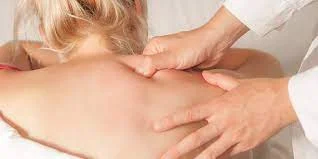
Conventional massage therapy can reduce muscle tension, but it frequently falls short of providing a full resolution. One kind of massage that focuses on releasing muscle knots is called trigger point massage. Trigger point massage helps relieve muscle tension and increase the range of motion by applying pressure to these knots. Furthermore, trigger point massage has been shown to improve circulation, which in turn helps reduce stress. Therefore, trigger point massage may be a useful technique for releasing shoulder and neck muscle knots.
Try self-massaging a trigger point to release a knotted muscle. To release the knot and loosen up the tense muscles, press on it.
This is how you do it:
- Fingers should be placed on the knot.
- Put in five to ten seconds of intense pressure. Let go.
- Up to six times a day, repeat for three to five minutes. Do it every day.
2. Ice or heat

The muscle pain that a knot causes may be relieved by applying heat or ice. Ice can aid in lowering swelling within and around the knot. Heat can calm down and relax the muscles. Choose the course of action that provides the greatest relief, or consider switching between the two.
To protect your skin when using this remedy, be sure to wrap the ice pack or heat source in a towel or piece of cloth. For fifteen to twenty minutes at a time, apply heat or an ice pack to the sore spot. Several times a day, repeat.
One option is to use a:
- Heating pad
- Bottle of hot water
- Heated or chilled compress
- An ice pack
To improve blood flow and relax the muscles, apply heat to the affected area. As an alternative, using ice can help to lessen pain and inflammation. Select the one that provides you with the greatest level of relief for the best outcomes. If you notice little to no difference, try applying heat and ice treatments alternately several times a day.
3.NSAIDs, or nonsteroidal anti-inflammatory drugs
OTC pain relievers also referred to as nonsteroidal anti-inflammatory drugs, or NSAIDs for short, are medications that reduce pain. They function by lowering inflammation, which regulates swelling and pain.
NSAID examples are as follows:
- Aspirin
- Ibuprofen (Motrin, Advil)
- Naproxen (Aleve)
NSAIDs can help relieve muscle knot pain, but only temporarily. They function best when combined with stretching and trigger point massage.
Physiotherapy
There are a variety of physical therapy modalities that can be used to treat knotted muscles in the neck or myofascial trigger points. A few of the more often-used methods include:
Manual therapy: This involves hands-on techniques such as massage, mobilization, and manipulation to release tension in the muscles and improve the range of motion in the joints. Manual therapy physical therapy modality
Therapeutic exercise: This involves specific exercises that are designed to stretch, strengthen, and coordinate the muscles in the neck. Therapeutic exercise physical therapy modality
Heat and cold therapy: Heat can help to relax muscles and reduce pain, while cold can help to reduce inflammation. and cold therapy physical therapy modality
Electrical stimulation: This involves using electrical currents to stimulate the muscles and reduce pain. stimulation physical therapy modality
Dry needling: This involves inserting thin needles into the trigger points to release tension. Dry needling physical therapy modality
The specific modalities that are used will depend on the individual’s condition and needs. A physical therapist will assess the patient’s condition and develop a treatment plan that is tailored to their specific needs
Muscle knots can be effectively relieved and kept from returning with physiotherapy. The therapist will improve the range of motion and release knots using various techniques, including massage and stretching. To help stop the knots from coming back, the therapist may also offer exercises and advice on good posture practices. Make an appointment with a physiotherapist right away if you are experiencing muscle knots. You will quickly feel better with their assistance.
After the muscle knot has been released, it’s important to understand how to keep it from returning.
Maintaining proper posture can help avoid muscle knots in addition to regular stretching and exercise. Additionally, take care to stay away from demanding or repetitive activities that could strain your muscles. Your neck muscles will become tense, for instance, if you spend hours upon hours sitting down. It’s important to remember to take sitting breaks to release tense or overworked muscles. Ultimately, maintaining adequate hydration and sleep patterns can also support the health of your muscles and help avoid the formation of knots. Muscle knots can cause pain and discomfort, but you can prevent them by taking preventative measures.
In conclusion, there are numerous approaches to treating and avoiding neck muscle knots. These consist of trigger point massage, stretches, myofascial release therapy, heat or ice treatments, and physical therapy. To stop muscle knots from happening again, don’t forget to maintain proper posture and stay away from overusing your muscles. You can wave goodbye to uncomfortable shoulder and neck knots with these steps.
Exercises and Stretches for Neck Knots
4. Shrugs of the shoulders
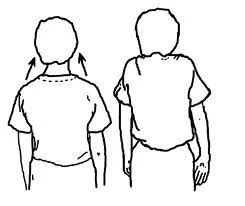
An exercise that works your neck, shoulders, and spine is the shoulder shrug. It involves soft shoulder motions that ease the nearby muscles.
To carry out this task:
- Either sit or stand straight.
- Take a breath. Raise and align your shoulders with your ears. Hold on.
- Let out a breath. Put your shoulders back where they were.
- Do two or three sets of ten repetitions each.
5. Neck release head-to-hand
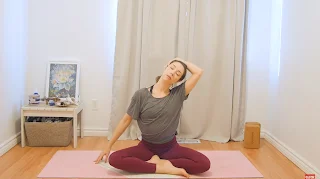
This stretch lengthens your neck’s muscles, which releases tension in your neck. It’s an excellent upper-body stretch because it also opens up your chest and biceps.
To perform this exercise:
- Cross your legs on the floor or in a chair. Set your back straight.
- Align the left ear with the left shoulder. At the same time, raise your right arm to shoulder height in line with your body. Spread your fingers apart and raise your thumb.
- With your fingers pointing down toward your right ear, place your left hand on your head. As you slowly bring your left ear closer to your left shoulder, apply minimal pressure.
- After a brief pause, exchange sides and continue.
6. Supine Chin Tucks
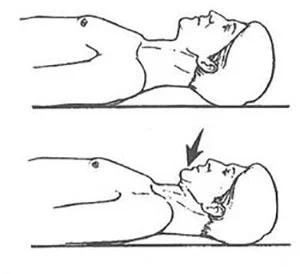
This is a simple exercise that helps release stiff neck muscles quickly. You can do it at various points during the day, at your desk, while commuting to work, or while getting dressed. After a long day of having your neck shortened, you can stretch it out by lying flat on the bed for five minutes without using a pillow below your head.
7. Back Rotation Stretch
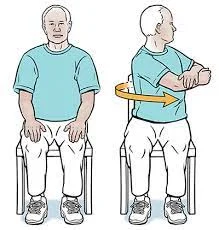
Don’t be confused by the name of this exercise — it’s all connected. This simple movement allows you to move your back and shoulders, and take your neck along for the ride
8. Neck stretches

Completing neck stretches is a great way to relieve tension, improve local circulation, and correct postural issues when dealing with neck pain. See below for some commonly prescribed stretches!
9. Chin Tucks
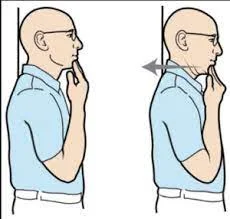
Chin tucks stretching exercise for knotted muscles
- Straighten your back and raise your head.
- Slowly tuck your chin towards your chest.
- Hold for 10-30 seconds.
- Relax and repeat.
10. Neck Rotation
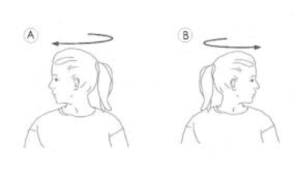
Neck rotation stretching exercise for knotted muscles
- Maintain a straight back and a raised head when you sit or stand.
- Look behind your shoulder while you slowly turn your head to one side.
- Hold for 10-30 seconds.
- Repeat on the other side
11. Neck Tilt
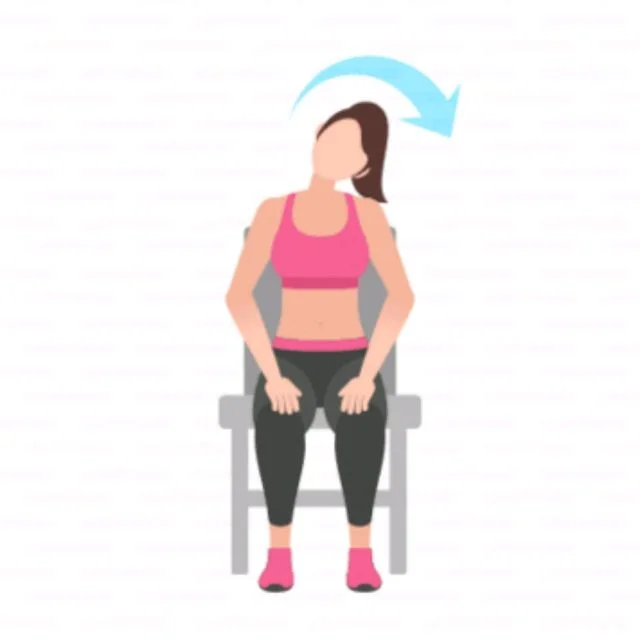
Neck tilt stretching exercise for knotted muscles
- Maintain a straight back and a proud head whether you’re sitting or standing.
- Bring your ear near your shoulder as you slowly cock your head to one side.
- Hold for 10-30 seconds.
- Repeat on the other side
12. Upper Trapezius Stretches
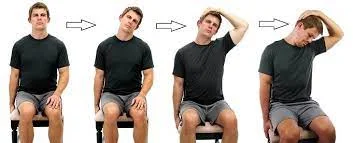
Upper trapezius stretches strengthening exercise
Upper trapezius stretches are a great way to stretch the muscles at the top of your shoulders. To do an upper trapezius stretch, sit or stand with your head held high. Shrug your shoulders up towards your ears, and then slowly lower them down. Repeat 10-15 times
Knotted Muscles in Neck Strengthening Exercises
Sure, here are some strengthening exercises for knotted muscles in the neck:
13. Neck Wall Raises
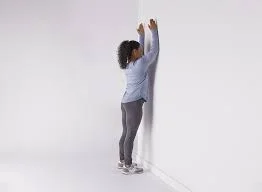
Neck wall raises strengthening exercise
Neck wall raises are a great way to strengthen the muscles on the sides of your neck. To do a neck wall raise, stand facing a wall with your hands on the wall at shoulder height. Slowly raise your head off the wall, and then slowly lower it back down. Repeat 10-15 times. high. Slowly tilt your head to one side, and then slowly tilt it to the other side. Repeat 10-15 times on each side.
14. Rotational Stretches
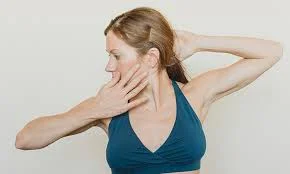
Rotational stretches strengthening exercise
Rotational stretches are a great way to stretch the muscles that rotate your neck. To do a rotational stretch, sit or stand with your head held high. Slowly rotate your head to one side, and then slowly rotate it to the other side. Repeat 10-15 times on each side.
15. Isometric Neck Strengthening
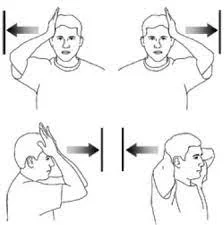
Isometric neck strengthening exercise
Isometric neck strengthening exercises involve contracting your neck muscles without actually moving your head. This can help to strengthen the muscles without putting strain on your neck. To do an isometric neck strengthening exercise, imagine that you are pressing your head against a wall without actually moving it. Take a few moments to hold, and then let go. Repeat ten to fifteen times.
Be sure to listen to your body and stop if you feel any pain. If you have any pre-existing neck conditions, be sure to talk to your doctor before starting any new exercise routine.
16. Cow-cat
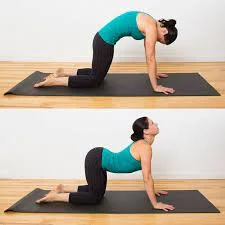
A traditional yoga pose that stretches the back and neck muscles is called the “Cow.” It involves extending and flexing your spine, which improves mobility and posture.
To perform this exercise:
- Start on all fours. Take a breath. Lower your belly while raising your chin to the ceiling.
- Let out a breath. Turn your chin toward your chest and round your back.
- For one minute, repeat.
Therapy using myofascial release
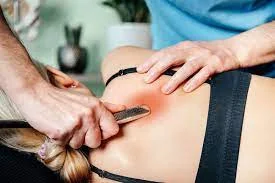
One kind of massage that targets these knots is called myofascial release therapy. To help release the tension in the muscles, the therapist will apply pressure to the knot. This may help with range of motion improvement and pain relief. Myofascial release therapy can also aid in preventing future muscle knot formation. The therapist can assist in lengthening and loosening the muscle fibers by focusing on the tense areas of the muscles. This can lessen the likelihood that the muscle will tense up again later on.
Yoga Poses for Tech Neck
here are some yoga poses that can be particularly helpful for knotted muscles in the neck, with more details and images:
Gentle Neck Rolls
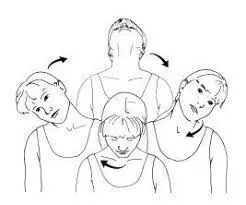
Start by sitting upright on a chair or mat, with your feet flat on the floor. Gently lower your chin to your chest, and then slowly roll your head to the right, bringing your right ear towards your right shoulder. Hold for a few seconds, and then slowly roll your head back to center. Repeat on the other side. Continue rolling your head in a circle, both clockwise and counterclockwise, for a few minutes.
Seated Forward Bend (Uttanasana):
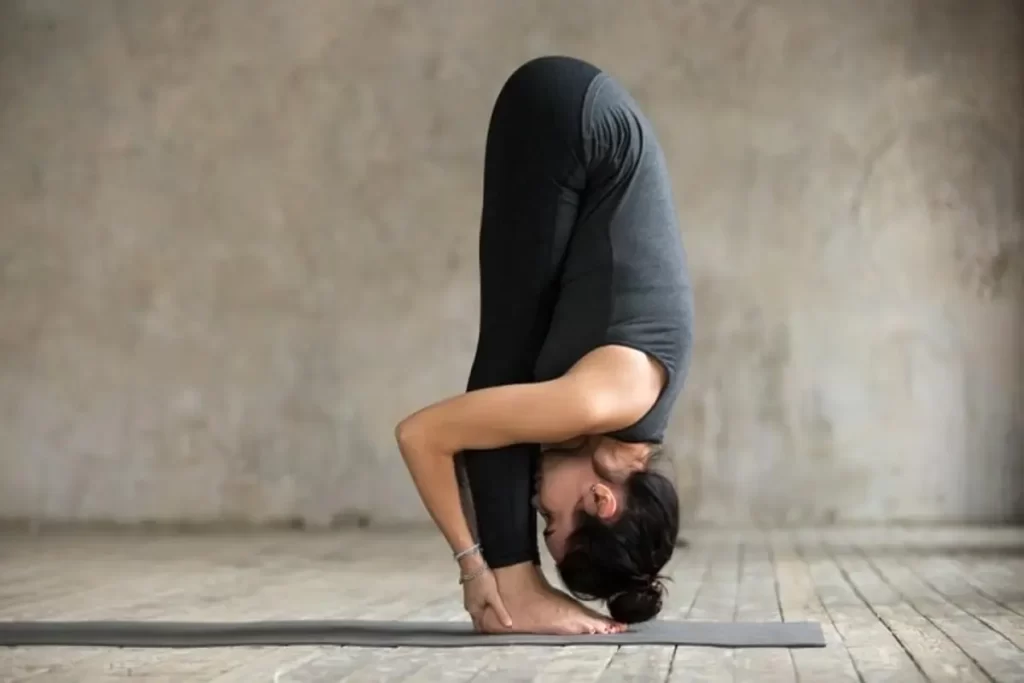
Seated Forward Bend yoga pose
With your legs in front of you, take an upright position on the floor. Hinge at the hips, fold from the waist, and let your head hang loose. Relax your shoulders and arms down towards the floor. If you can, reach towards your toes or shins. Hold for a few breaths, and then slowly come back up to a seated position.
Thread the Needle Pose (Pasasana):
Thread the Needle yoga pose
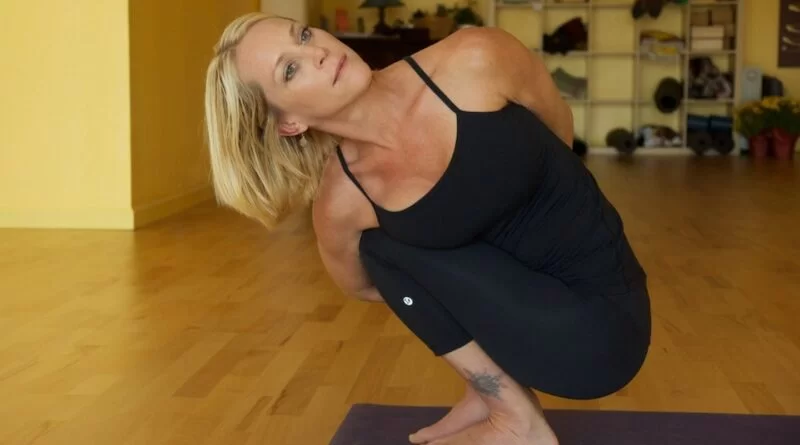
Place your knees hip-width apart on the ground. With your right hand on the ground outside of your left shoulder, bring your right arm under your left arm. Raise your left arm in the air and reach up towards the sky. If you cannot reach the floor with your right hand, use a block or rolled-up towel for support. After a few breaths of holding, switch to the opposite side and repeat.
Cow Face Pose (Gomukhasana):
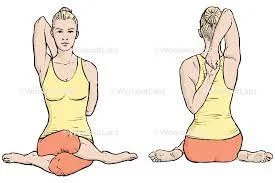
Cross your right ankle over your left thigh, bringing your right knee closer to your chest. Bend your right elbow and bring your right forearm up towards your ear. Pass your left arm behind your back and reach for your right hand. If you cannot reach your right hand, use a strap or towel to assist you. After a few breaths of holding, switch to the opposite side and repeat.
Child’s Pose (Balasana)
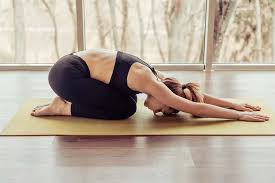
Child’s Pose yoga pose
Place your knees hip-width apart on the ground. With your forehead lying on the floor and your waist folded forward, take a seat back on your heels. Arms should be extended out in front of you or beside your body. Breathe deeply and let your body come to rest. Hold on for just a moment.
Please note that these are just a few suggestions, and many other yoga poses can be helpful for knotted muscles in the neck. Be sure to listen to your body and avoid any poses that cause pain.
Ways to Deal with and Avoid Neck Knots
You can take other measures at home to assist in alleviating neck knots in addition to stretching. Additionally, these actions may assist in avoiding muscle knots.
Take a deep breath.
Breathing carefully and slowly can help you release knots in your muscles and relax your muscles. It could be beneficial to set a reminder on your phone or calendar to take five deep breaths a few times a day, as many people are too busy to stop and consider how they’re breathing.
Self-massage.
You can try to rub out the knot if you gently squeeze your muscles and use your thumb to massage the tissue in a circular motion. Additionally, you could invest in a few massages. Treatment for chronic neck pain may involve four weeks of multiple 60-minute massages per week.
Stay active.
Even when you are in pain, moving around is generally safe. Your neck muscles can become more supple and relaxed as a result of exercise, which maintains blood flow to all of your muscles. Adding little bursts of movement throughout the day is also beneficial.
Heat.
In addition to improving circulation, a heating pad can ease knot tension. If you have a neck knot as a result of an injury or trauma (like a car accident), applying ice for a few days in advance can help reduce pain and swelling
Dry needling.
With this method, the knot is attempted to be loosened by injecting a tiny needle into it. Either an acupuncturist or a physical therapist performs it. Needling has been shown in studies to be effective in treating neck pain. If you employ wet needling, which involves anesthesia, you might see better outcomes. It’s important to combine long-term healing methods like movement with techniques like dry needling if you decide to use them.
Examine the area where you work. You can take easy steps to modify your workspace to reduce the likelihood of getting a knot in your neck. Changing positions frequently is the best way to stop neck knots from forming during the workday. Additional helpful methods include:
Immediately put your computer at eye level in front of you. You’ll be able to prevent the strain of your head tilting forward in this way. Place one screen in the center and the other to your left or right if you have two screens.
Employ a wireless keyboard. Enabling you to arrange the keyboard in a comfortable position, can lessen the risk of neck strain. Try to maintain a neutral wrist position, relaxed shoulders, and a 90-degree bend in your elbows if you are unable to use a wireless keyboard.
Can you prevent muscle knots from forming?
Absolutely. The best medicine is prevention. Muscle knots can be prevented by following these recommendations:
Is it possible to stop muscle knots from developing?
Actually. The best medicine is, in fact, prevention. Muscle knots can be prevented by following these recommendations:
Practice stress-relieving techniques. Life will inevitably involve stress. However, there are a few strategies to assist you in handling it. To relieve stress, try going outside, practicing meditation, and other techniques.
Engage in regular exercise. To avoid muscular imbalances and knots, keep your body moving. Exercises for strength and aerobic training should be part of your regimen.
Take breaks to stretch. Throughout the day, take periodic breaks to stretch actively. Stretching frequently keeps your muscles loose and flexible. It’s even possible to work out at your desk.
Verify that your workstation is configured correctly. An ergonomic workstation relieves physical strain on the body. It’s also crucial if your job involves standing for extended periods or if you work at a desk.
Maintain hydration and eat a balanced diet. Muscle function is aided by a healthy diet and sufficient hydration. Additionally, it might prevent cramps or knots in your muscles.
Relax. You need to sleep if you want to be healthy and happy. If overtraining is the cause of your muscle knots, modify your exercise regimen. Lower-intensity exercises that allow your muscles to adapt can help you practice active recovery.
What Happens If the Muscle Knots Remain?
In most cases, at-home treatment and time will cause a tense muscle to relax. Muscle knots, also known as myofascial pain syndrome, are a hereditary condition that affects some people. Among the signs of myofascial pain syndrome to watch out for are:
- Pain that continues or becomes worse
- Pain that keeps you awake
- A muscle sore spot that never goes away
- Severe musculoskeletal pain
If you have difficulty with muscle knots regularly or if you encounter any of these symptoms, speak with your doctor about treatment options. They could suggest:
- Physiotherapy to improve the strength and endurance of muscles
- Myofascial release therapy involves gently applying sustained pressure to the myofascial connective tissue limitations to reduce pain and restore mobility.
- giving the sore spot an injection to cause numbness
- A physician may employ dry needling, which involves inserting tiny needles into the trigger point, to reduce discomfort.
- One traditional approach to using needles to relieve pain is acupuncture.
- Waves of ultrasonic radiation to enter muscles
- Transcutaneous electrical nerve stimulation, or TENS therapy, uses a small electrical current to relax muscles.
Risk Factors for Knotted Muscles in Neck
Several factors can increase your risk of developing knotted muscles in your neck. Here are some of the most common:
Physical factors:
- Muscle overuse or strain: This is a major contributor to knotted muscles, especially from repetitive motions like:
- Sitting at a computer for extended periods
- Holding your phone in your neck for long stretches
- Playing sports with repetitive neck movements
- Engaging in physically demanding jobs with repetitive motions
- Poor posture: Slouching and hunching can strain your neck muscles, causing them to tighten and form knots.
- Injury: Whiplash injuries, falls, and other traumas to your neck can damage muscles and lead to knot formation.
- Muscle imbalances: When certain muscles are weaker or tighter than others, it can lead to overcompensation and tension in other muscles, including those in the neck.
- Lack of physical activity: If you don’t exercise regularly, your neck muscles can become weak and more prone to injury and knotting.
Lifestyle factors:
- Stress and anxiety: Chronic stress can cause muscle tension throughout your body, including your neck.
- Sleep deprivation: When you don’t get enough sleep, your muscles don’t have time to properly repair themselves, making them more susceptible to injury and knotting.
- Dehydration: Dehydration can lead to muscle fatigue and tension, increasing the risk of knots.
- Poor nutrition: Eating a diet that is high in processed foods and sugar can contribute to inflammation throughout the body, including in your muscles.
Other factors:
- Age: As you age, your muscles lose elasticity and become more susceptible to injury and knotting.
- Gender: Women are more likely than men to develop knotted muscles in their necks.
- Certain medical conditions: Some medical conditions, such as fibromyalgia and arthritis, can make you more prone to developing muscle knots
Here are some tips to reduce your risk of developing knotted muscles in your neck:
- Maintain good posture: Be mindful of your posture throughout the day and avoid slouching or hunching.
- Take breaks from sitting: Get up and move around every 20-30 minutes, especially if you have a desk job.
- Stretch regularly: Incorporate stretches for your neck and shoulders into your daily routine.
- Engage in regular exercise: Try to get in at least 30 minutes a day, most days of the week, of moderate-intense activity.
- Reduce stress by finding healthy coping mechanisms, such as yoga, meditation, or time spent in nature.
- Keep your muscles hydrated by drinking lots of water throughout the day.
- Eat a healthy diet: Eat a diet rich in fruits, vegetables, and whole grains to provide your body with the nutrients it needs to repair and maintain muscle health.
- Get enough sleep: Aim for 7-8 hours of sleep each night.
- See a doctor: If you experience persistent neck pain or have difficulty moving your neck, see a doctor to rule out any underlying medical conditions.
By following these tips and being aware of the risk factors, you can help to prevent knotted muscles in your neck and keep your neck pain-free
Prevention
Here are some tips for preventing knotted muscles in the neck:
Maintain good posture: Good posture helps to keep your spine aligned and reduces strain on your neck muscles. When standing, keep your shoulders back and relaxed, your head held high, and your chin tucked in slightly. Make sure your feet are flat on the floor and your back is straight as you sit.
Take breaks from sitting: If you sit for long periods, it’s important to take breaks to get up and move around. This helps to prevent your muscles from getting stiff and tight.
Stretch regularly: Stretching helps to improve flexibility and range of motion in your neck muscles. There are many different neck stretches that you can do, so find a few that you enjoy and do them regularly.
Strengthen your neck muscles: Strengthening your neck muscles can help to support your head and prevent it from straining. There are a few different exercises that you can do to strengthen your neck muscles, such as neck raises and shrugs.
Manage stress: Stress can contribute to muscle tension in the neck. Look out for helpful stress-reduction methods, such as yoga, meditation, or outdoor activities.
Avoid repetitive movements: Repetitive movements can put strain on your neck muscles and contribute to knotted muscles. If you have a job that requires repetitive movements, take breaks to stretch and change positions.
Use a supportive pillow: When you sleep, your head should be in a neutral position. This means that your neck should not be too high or too low. A supportive pillow can help to keep your head in a neutral position and prevent muscle strain.
See a massage therapist: A massage therapist can help to release tension in your neck muscles and prevent knotted muscles from developing.
By following these tips, you can help to prevent knotted muscles in your neck and keep your neck healthy and pain-free
Complication
While they are usually not serious, some potential complications can arise if they are not properly treated.
Here are some of the potential complications of knotted muscles in the neck:
Increased pain: If knotted muscles are not treated, they can become more painful and difficult to treat.
Reduced range of motion: Knotted muscles can tighten and restrict the movement of your neck, making it difficult to turn your head or look up and down.
Headaches: Knotted muscles in the neck can cause pain in the head, causing headaches.
Muscle spasms: Uncontrollably strong, sudden contractions of the muscles. They can be very painful and can make it difficult to move your neck.
Nerve compression: In rare cases, knotted muscles can compress nerves in the neck, leading to weakness, numbness, or tingling in the arms or hands
Conclusion
Knotted muscles in the neck, while uncomfortable, are often harmless and can resolve on their own. Treatment options like massage stretches, and pain relievers can help speed up healing and reduce discomfort. Maintaining good posture, managing stress, and staying active are key preventative measures. If the knots are causing severe pain or any concerning symptoms, consult a healthcare professional for diagnosis and treatment. Remember, taking care of your neck muscles can make a big difference in your overall well-being.
I need to understand:
1. Symptoms: Describe the specific symptoms you’re experiencing, such as pain level, location, duration, and any associated symptoms like headaches or dizziness.
2. Cause: If known, share the cause of your muscle knots. Did it start after an injury, poor posture, stress, or something else?
3. Treatment: Have you tried any treatments for the knots, such as massage, stretches, or medication?
4. Medical history: Mention any relevant medical history that might be contributing to the issue.
With this information, I can provide a more accurate and relevant conclusion about your neck muscle knots.
In the meantime, here are some general conclusions about muscle knots:
- Muscle knots are often harmless and resolve on their own.
- Treatment can help relieve pain and accelerate healing.
- Preventing muscle knots involves maintaining good posture, managing stress, and staying active.
Remember, if you are experiencing severe pain or any concerning symptoms, it’s crucial to consult a healthcare professional for proper diagnosis and treatment.
FAQs
What occurs if knots are not removed?
Don’t let the fact that knots are very prevalent lead you to believe they are harmless. If the muscle tissue is not treated, it may continue to lose its flexibility and result in postural issues, which can be difficult to correct.
Do knots in the neck stay in place forever?
Although neck muscle knots normally disappear on their own in a few days, there are steps you may take to speed up the healing process. You can try using your fingers to massage the knot in your muscles, applying an ice pack or heating pad to minimize inflammation, and stretching to relieve the tension in your muscles.
How can I sleep easier if I have neck pain?
Which sleeping posture is best for relieving neck pain? Lying on your side or back are the two sleeping postures that are least taxing on the neck. If you sleep on your back, place a flatter pillow under your head and use a circular pillow to support the natural curve of your neck.
Are tense muscles a result of stress?
Stress causes your body to overproduce some hormones, which heightens neuronal activation. Acetylcholine is released more frequently as a result, which increases muscular over-contraction and increases the risk of knot development. When muscles are kept in a state of continual tension, stiffness may develop.
For muscle knots, what kind of massage works best?
massage with deep tissue
The finest massage for reducing stress and tension in the muscles is deep tissue. Using a mix of strong pressure and gradual strokes, deep tissue massage can realign deeper layers of muscle and release uncomfortable “knots.” Your therapist will work on connective tissue in addition to the typical muscles.
Can major muscular knots occur?
Though they are common, muscular knots are not always harmless. A muscular knot that is causing excruciating discomfort could be tearing at the muscle tissue’s microfibers. This tearing may eventually result in scarring and a loss of tissue flexibility.
Is massaging knots in the muscles okay?
Muscle knots can be relieved, reduced, or even prevented with the use of massage treatment techniques. Sports massage techniques and deep tissue massage target tense or knotted muscles. Firm, targeted pressure applied to the areas of constriction, or “knots,” during trigger point massage might result in the release of that knot.
What differentiates a muscle knot from a lump?
Therapists identify painful lumps in your muscles as muscle knots. The pain and tightness are palpable, even though there isn’t a real knot in the muscle. Instead, it feels like one. The lump is made up of a portion of your muscle that has tensed and won’t release.
How much time is ideal to massage a knot?
For some, deep tissue work and trigger point therapy—which involves holding a position for a long time and moving slowly to release—are necessary. The duration of each knot may vary between 5 and 10 minutes, contingent upon the holding patterns of the body. Some people need an athletic massage or even a more delicate approach to relaxation, which may seem contradictory.
Reference
- 4 Ways to Stop Getting Knots in Your Neck Muscles: Bonaventure Ngu, MD: Orthopaedic Spine Surgeon. (n.d.). Bonaventure Ngu, MD. https://www.premierspineinstitute.com/blog/4-ways-to-stop-getting-knots-in-your-neck-muscles#
- Nunez, K. (2019, November 20). 7 Ways to Relieve a Knot in Your Neck. Healthline. https://www.healthline.com/health/knot-in-neck
- GoodRx – Error. (n.d.). https://www.goodrx.com/conditions/musculoskeletal/muscle-knots
- Supine Chin Tucks. (n.d.). Hingehealth. https://www.hingehealth.com/resources/articles/muscle-knots-in-neck/
- Sipos, T. (2023, April 17). 5 Simple Ways To Relieve Muscle Knots In the Neck – PainHero. PainHero. https://painhero.ca/blog/5-simple-ways-to-relieve-muscle-knots-in-the-neck/
- C. (2023, March 21). The Complete Guide For Muscle Knots. Canadian Chiropractic Association (CCA). https://chiropractic.ca/muscle-knots/
- What to Know About Muscle Knots. (2021, April 8). WebMD. https://www.webmd.com/fitness-exercise/what-to-know-muscle-knots

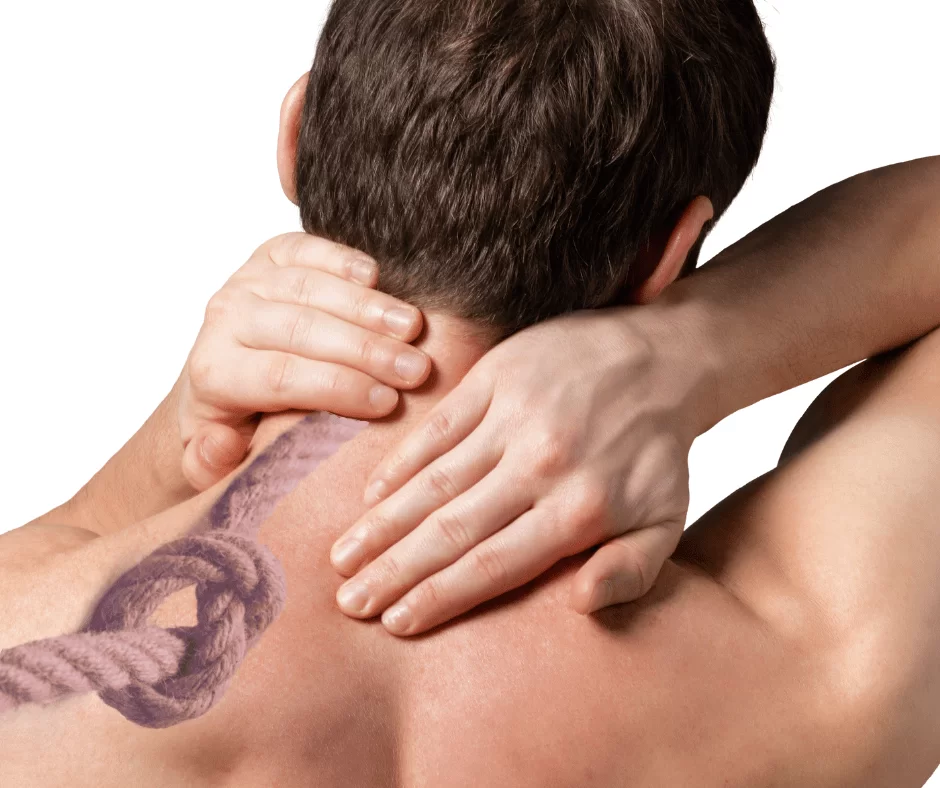
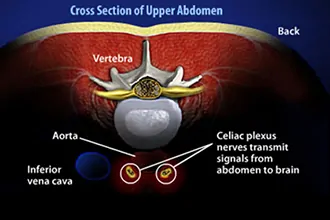
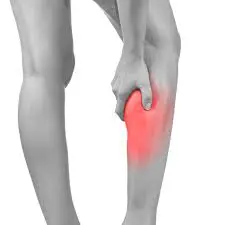
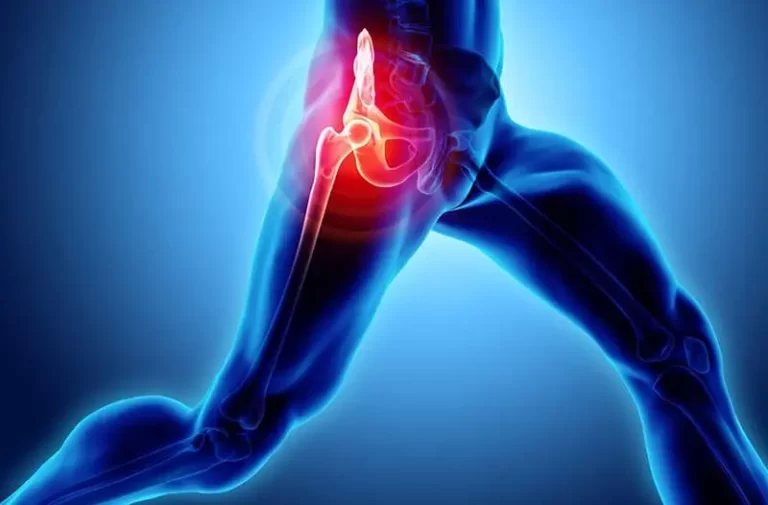
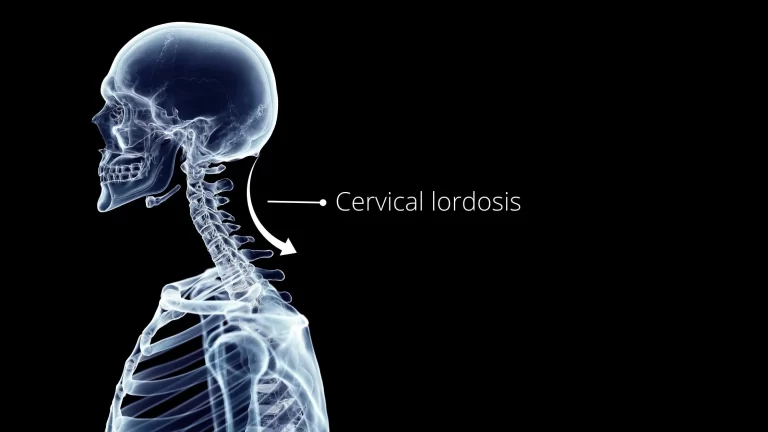
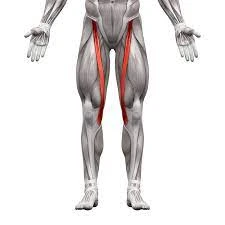
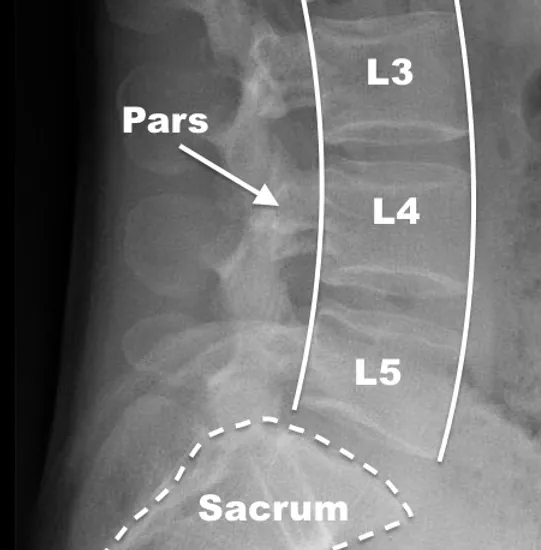
One Comment